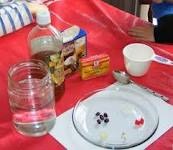Floating and Sinking Experiment
Materials:
- Clear plastic or glass container
- Water
- Vinegar
- Baking Soda
- Food Coloring
- Items such as raisins, rice, dried fruit and broken pieces of spaghetti
Directions:
- Almost fill the container with 3 parts water and 1 part vinegar.
- Slowly add one teaspoon of baking soda, very slowly! Too much at one time and it will bubble over the top. Have a towel handy in case.
- When the bubbles settle down, slowly add a second teaspoon of baking soda.
- When the bubble settle, add a few drops of food coloring. Notice the liquid is moving and quickly mixes the color.
- Now comes the fun part. Find some interesting food items. Ask the children if they think the items will sink or float.
- Drop in a few of the first item. Usually they will sink to the bottom. Wait a few minutes and then they will rise to the surface, then sink again. Rice almost seems to dance.
- If the movement seems to be slowing down, add another teaspoon of baking soda.
- What is happening? The vinegar is an acid and the baking soda is a base. when you combine them, a chemical reaction produces carbon dioxide.
- The carbon dioxide bubbles build up on the surface of the object. When enough bubbles attach to the object, it floats to the surface and releases the gas. The it sinks back to the bottom to start the process again.

Source:
adapted from www.sciencekidsathome.com




